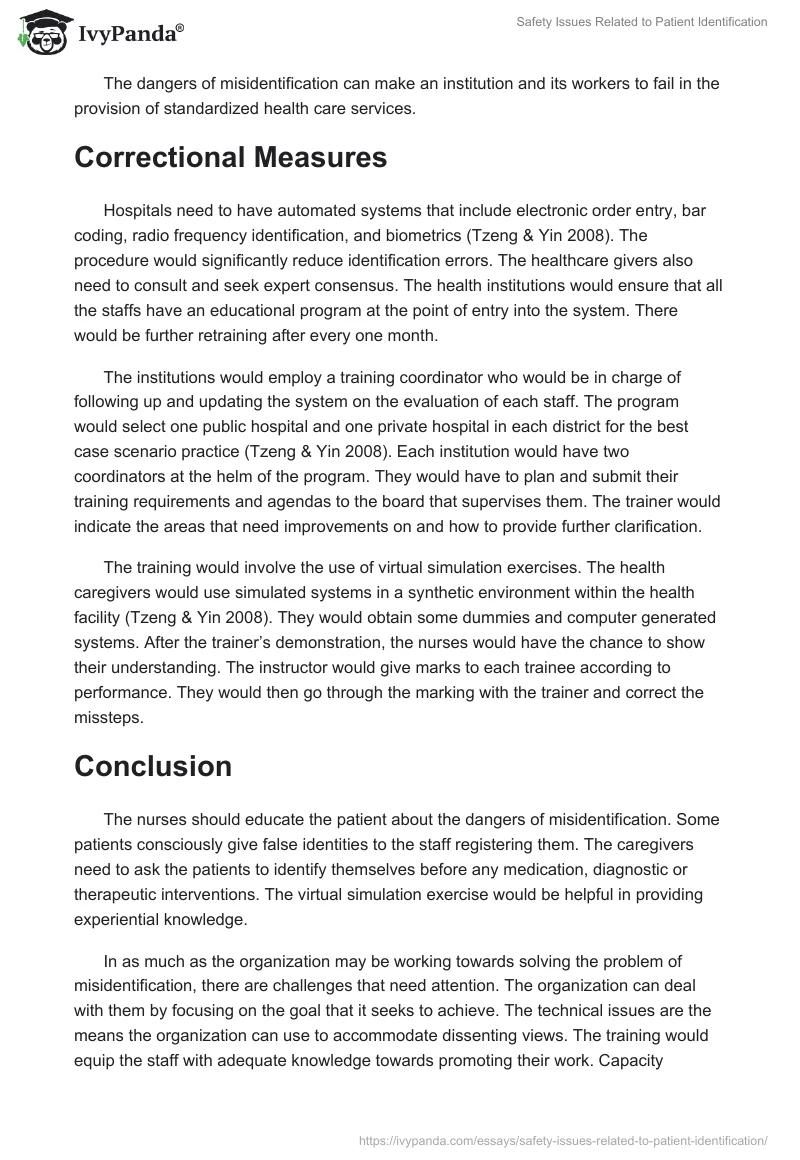Introduction
Patient identification is critical for all health care facilities. Apart from the conventional identification procedures, the healthcare givers need to come up with improvised measures. Misidentification can result in a wrong diagnosis and treatment. The focus of the discussion would involve the dangers of misidentification.
Dangers of Misidentifying the Patient
Misidentifying a patient can lead to an erroneous admission. When the admission process misses a particular function of identification, it may lead to many other internal errors. The names may misrepresent a patient. The patient’s visitors may have problems in locating him or her whenever they come to the hospital (Kingston-Riechers 2010).
It can also lead to wrong person procedures and discharge of infants to the wrong families (Wong, Hockenberry & Wilson 2011). The drug administration and phlebotomy require correct patient identification. The institutions would have to provide corrective measures to ensure that they provide reliable services.
Challenges to Identification Procedures
Some institutions have culture issues that they need to deal with first (Tzeng & Yin 2008). They may include stigma of the white identification band, a similarity in the names, clothing that may conceal the identities. Some healthcare providers may not be familiar with certain local names. When the hospital staffs do not involve the patient in the identification process, it can result in misidentification (Kingston-Riechers 2010).
All healthcare institutions should have a patient identification strategy that is working and essential for all their health care consumers.
The dangers of misidentification can make an institution and its workers to fail in the provision of standardized health care services.
Correctional Measures
Hospitals need to have automated systems that include electronic order entry, bar coding, radio frequency identification, and biometrics (Tzeng & Yin 2008). The procedure would significantly reduce identification errors. The healthcare givers also need to consult and seek expert consensus. The health institutions would ensure that all the staffs have an educational program at the point of entry into the system. There would be further retraining after every one month.
The institutions would employ a training coordinator who would be in charge of following up and updating the system on the evaluation of each staff. The program would select one public hospital and one private hospital in each district for the best case scenario practice (Tzeng & Yin 2008). Each institution would have two coordinators at the helm of the program. They would have to plan and submit their training requirements and agendas to the board that supervises them. The trainer would indicate the areas that need improvements on and how to provide further clarification.
The training would involve the use of virtual simulation exercises. The health caregivers would use simulated systems in a synthetic environment within the health facility (Tzeng & Yin 2008). They would obtain some dummies and computer generated systems. After the trainer’s demonstration, the nurses would have the chance to show their understanding. The instructor would give marks to each trainee according to performance. They would then go through the marking with the trainer and correct the missteps.
Conclusion
The nurses should educate the patient about the dangers of misidentification. Some patients consciously give false identities to the staff registering them. The caregivers need to ask the patients to identify themselves before any medication, diagnostic or therapeutic interventions. The virtual simulation exercise would be helpful in providing experiential knowledge.
In as much as the organization may be working towards solving the problem of misidentification, there are challenges that need attention. The organization can deal with them by focusing on the goal that it seeks to achieve. The technical issues are the means the organization can use to accommodate dissenting views. The training would equip the staff with adequate knowledge towards promoting their work. Capacity building helps to find the best way to solve the impending problems that the organization is facing in its delivery of service.
The virtual simulation training would be a major milestone in curbing the problem of misidentification.
References
Kingston-Riechers, J 2010, Patient safety in primary care, Canadian Patient Safety Institute, Edmonton, Alberrta.
Tzeng, H & Yin, C 2008, Patient unit safety and care quality, Nova Biomedical Books, New York.
Wong, D., Hockenberry, M & Wilson, D 2011, Wong’s nursing care of infants and children, Mosby/Elsevier., St. Louis, Missouri.


